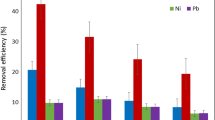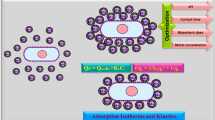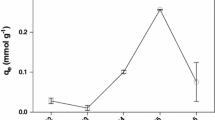Abstract
Heavy metal ions (Pb2+, Cd2+, Ni2+, and Zn2+) were biosorbed by brown seaweed (Hizikia fusiformis), which was collected from Jeju Island of South Korea. The metal adsorption capacity of H. fusiformis improved significantly by washing with water or by base or acid treatments. The maximum sorption by NaOH-pretreated biomass was observed near a slightly acidic pH (pH 4−6) for Pb2+, Cd2+, Ni2+, and Zn2+. This result suggests that the treatment of H. fusiformis biomass with NaOH helped increase the functional forms of carboxylate ester units. Kinetic data showed that the biosorption occurred rapidly during the first 60 min, and most of the heavy metals were bound to the seaweed within 180 min. The maximum metal adsorption capacities assumed by a Langmuir model were on the order of Pb2+ > Cd2+ > Ni2+ > Zn2+. Equilibrium adsorption data for the heavy metal ions could fit well in the Langmuir model with regression coefficients R 2 > 0.97.






Similar content being viewed by others
References
Aziz HA, Adlan MN, Ariffin KS (2008) Heavy metals (Cd, Pb, Zn, Ni, Cu and Cr(III)) removal from water in Malaysia: post treatment by high quality limestone. Bioresour Technol 99:1578–1583
Babel S, Kurniawan TA (2003) Low-cost adsorbents for heavy metals uptake from contaminated water: a review. J Hazar Materi B97:219–243
Boonamnuayvitaya V, Chaiya C, Tanthapanichakoon W, Jarudilollul S (2004) Reomval of heavy metals by adsorbents prepared from pyrolyzed coffee esidues and clay. Sep Purif Technol 35:11–22
Chatjigakis AK (1998) FTIR spectroscopic determination of the degree of esterification of cell wall pectins from stored peaches and correlation to texture changes. Carbohydr Polym 37:395–408
Chen B, Zhou DD, Zhu L, Shen XY (2008) Sorption characteristics and mechanisms of organic contaminant to carbonaceous biosorbents in aqueous solution. Sci China Ser B-Chem 51:464–472
Cruz CCV, de Costa ACA, Henriques CA, Luna Claudio AS (2004) Kinetic modeling and equilibrium studies during cadmium biosorption by dead sargassum sp. Biomass Biores Technol 91:249–257
Davis TA, Volesky B, Mucci A (2003) A review of the biochemistry of heavy metal biosorption by brown algae. Water Res 37:4311–4330
Guo XY, Zhang AZ, Shan XQ (2008) Adsorption of metal ions on lignin. J Hazard Mater 151:134–142
Hammaini A, Gonzalez F, Ballester A, Blazquez ML, Munoz JA (2007) Biosorption of heavy metals by activated sludge and their desorption characteristics. J Environ Manage 84:419–426
Hashim MA, Chu KH (2004) Biosorption of cadmium by brown, green, and red seaweeds. Chem Eng J 97:249–255
Ho YS (2005) Effect of pH on lead removal from water using tree fern as the sorbent. Biores Technol 96:1292–1296
Ho YS, Mckay G (1999) Pseudo-second order model for sorption processes. Process Biochem 34:451–465
Horsfall M Jr, Abia AA (2003) Sorption of cadmium(II) and zinc(II) ions from aqueous solutions by cassava waste biomass (manihot sculenta Cranz). Water Res 37:4913–4923
Lee SH, Park CH (2012) Biosorption of heavy metal ions by brown seaweeds from southern coast of korea. Biotechnol Bioprocess Eng 17:853–861
Lee MG, Lim JH, Kam SK (2002) Biosorption characteristics in the mixed heavy metal solution by biosorbents of marine brown algae. Korean J Chem Eng 19:277–284
Leon y Leon CA, Radovic LR (1994) In: Thrower PA (ed) Chemistry and physics of carbon. Marcel Dekker, New York, pp 213–310
Lesage E, Mundia C, Rousseau DPL, Van de Moortel AMK, Du Laing G, Meers E, Tack FMG, De Pauw N, Verloo MG (2007) Sorption of Co, Cu, Ni and Zn from industrial effluents by the submerged aquatic macrophyte Myriophyllum spicatum L. Ecol Eng 30:320–325
Liu Y, Cao Q, Luo F, Chen J (2009) Biosorption of Cd2+, Cu2+, Ni2+ and Zn2+ ions from aqueous solutions by pretreated biomass of brown algae. J Hazard Mater 163:931–938
Matheickal JT, Yu Q (1999) Biosorption of lead(II) and copper(II) from aqueous solutions by pretreated biomass of Australian marine algae. Bioresource Technol 69:223–229
Matheickal JT, Yu Q, Woodburn GM (1999) Biosorption of cadmium(II)from aqueous solutions by pretreated biomass of marine alga Durvillaea potatorum. Water Res 33:335–342
Mathialagan T, Viraraghavan T (2003) Adsorption of camium from aqueous solutions by vermiculite. Sep Sci Technol 38:57–76
Pasavant P, Apriatikul R, Sungkhum V, Suthiparinyanont P, Wattanachira S, Marhaba TF (2006) Biosorption of Cu2+, Cd2+, Pb2+, and Zn2+ using dried marine green macroalga Caulerpa lentillifera. Bioresour Technol 97:2321–2329
Raize O, Argaman Y, Yannai S (2004) Mechanisms of biosorption of different heavy metals by brown marine macroalgae. Biotech Bioeng 87:451–458
Rivera-Utrilla J, Lopez-Peinado A, Moreno-Castilla C, Lopez-Gonzalez JD (1987) Reactivity of Spanish coal chars in dry air: effect of the addition of potassium carbonate and acetate. Fuel 66:237–241
Romera E, González F, Ballester A, Blázquez ML, Muńoz JA (2006) Biosorption with Algae: a statistical review. Crit Rev Biotechnol 26:223–235
Sheng PX, Ting YP, Chen JP, Hong L (2004) Sorption of lead, copper, cadmium, zinc, nickel by marine algal biomass: characterization of biosorptive capacity and investigation of mechanisms. J Colloid Interface Sci 275:131–141
Solum MS, Pugmire RJ, Jagtoyen M, Derbyshire F (1995) Evolution of carbon structure in chemically activated wood. Carbon 33:1247–1254
Southichak B, Nakano K, Nomura M, Chiba N, Nishimura O (2006) Phragmites australis: a novel biosorbents for the removal of heavy metals from aqueous solution. Water Res 40:2295–2302
Villaescusa I, Fiol N, Martinez M, Miralles N, Poch J, Serarols J (2004) Removal of copper and nickel ions from aqueous solutions by grape stalks wastes. Water Res 38:992–1002
Volesky B, Holan ZR (1995) Biosorption of heavy metals. Biotechnol Prog 11:235–250
Wang J, Chen C (2009) Biosorbents for heavy metals removal and their future. Biotechno Advance 27:195–226
Yu Q, Matheickal JT (1999) Heavy metal uptake capacities of common marine macroalgal biomass. Water Res 33:1534–1537
Yun YS, Park D, Park JM, Volesky B (2001) Biosorption of trivalent chromium on the brown seaweed biomass. Environ Sci Technol 35:4353–4358
Zhao M, Duncan JR (1998) Removal and recovery of nickel from aqueous solution and electroplating effluent using Azolla filiculoides. Process Biochem 33:249–255
Acknowledgments
This research was a part of the project titled “Development of Sustainable Remediation Technology for Marine Contaminated Sediments” funded by the Ministry of Oceans and Fisheries, Korea.
Author information
Authors and Affiliations
Corresponding author
Rights and permissions
About this article
Cite this article
Shin, WS., Kim, YK. Biosorption characteristics of heavy metals (Ni2+, Zn2+, Cd2+, Pb2+) from aqueous solution by Hizikia fusiformis . Environ Earth Sci 71, 4107–4114 (2014). https://doi.org/10.1007/s12665-013-2799-8
Received:
Accepted:
Published:
Issue Date:
DOI: https://doi.org/10.1007/s12665-013-2799-8




